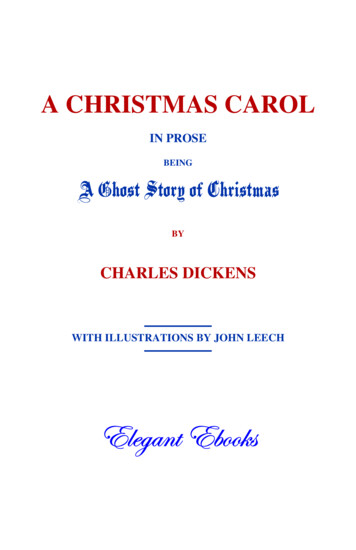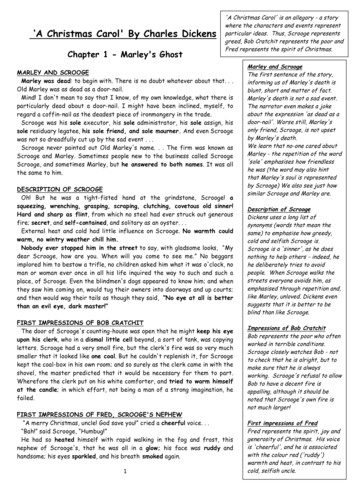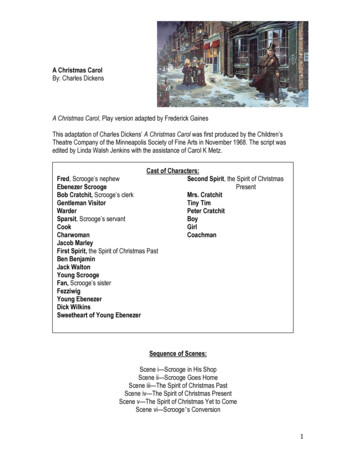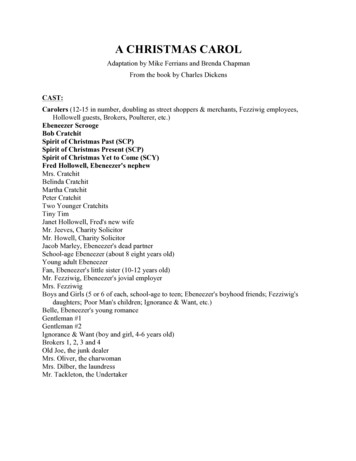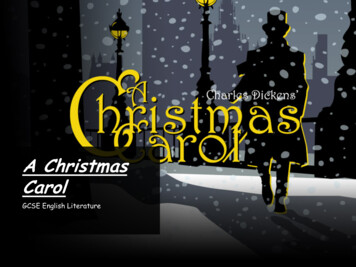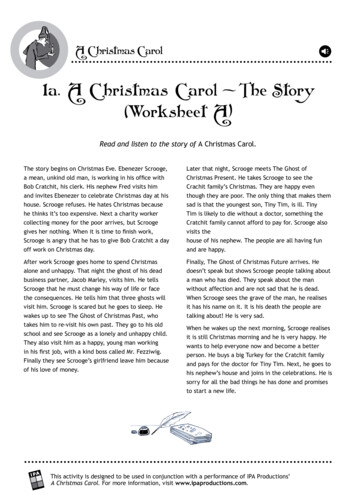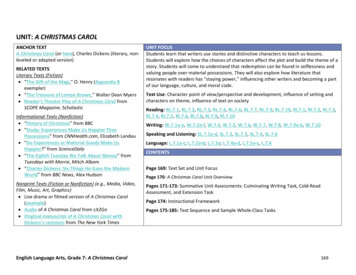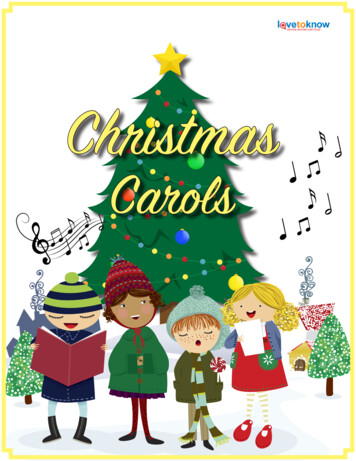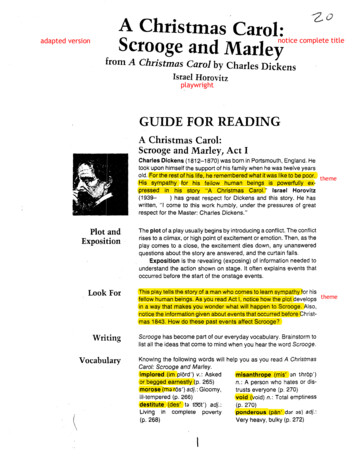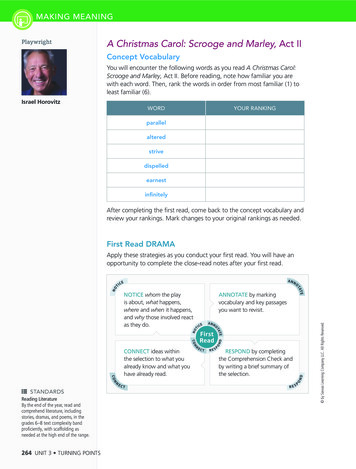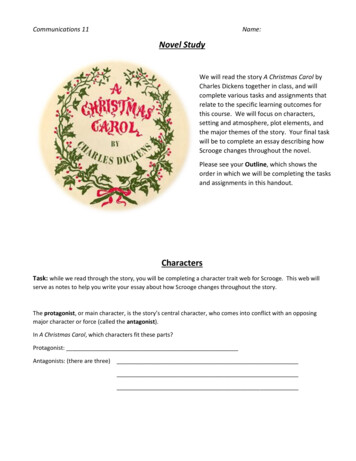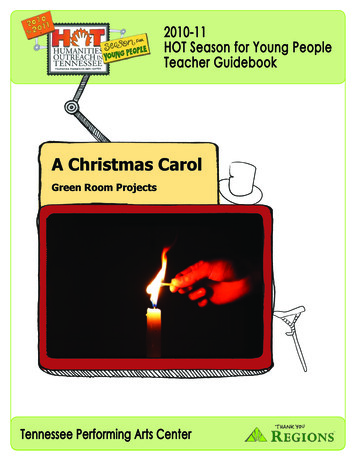
Transcription
2010-11HOT Season for Young PeopleTeacher GuidebookA Christmas CarolGreen Room ProjectsTennessee Performing Arts Center
TPAC Education is made possible inpart by the generous contributions,sponsorships, and in-kind gifts from thefollowing corporations, foundations,government agencies, and otherorganizations.AT&TAmerican AirlinesThe Atticus TrustBank of AmericaBaulch Family FoundationBMIBridgestone Americas Trust FundBrown-FormanCal IV EntertainmentCaterpillar Financial ServicesCorporationCentral Parking CorporationCoca-Cola Bottling Co.The Community Foundationof Middle TennesseeCorrections Corporationof AmericaThe Danner FoundationDavis-Kidd Booksellers Inc.The Dell FoundationDollar General CorporationDoubletree Hotel DowntownNashvilleFidelity Offset, Inc.First Tennessee BankSamuel M. Fleming FoundationPatricia C. & Thomas F. FristDesignated Fund*Gannett FoundationGaylord Entertainment FoundationThe Gibson FoundationLandis B. Gullett Charitable LeadAnnuity TrustGroupXcelHCA-Caring for the CommunityIngram Arts Support Fund*Ingram Charitable Fund, Inc.*Lipman Brothers, Inc.Mapco Express/Delek USMeharry Medical CollegeThe Memorial FoundationMetropolitan Nashville AirportAuthorityMiller & Martin, PLLCMorton’s,The Steakhouse,NashvilleNashville Predators FoundationNational Endowment for the ArtsNissan North America, Inc.NovaCopyPiedmont Natural Gas FoundationPinnacle Financial PartnersThe Premiere EventPublix Super Markets CharitiesMary C. Ragland FoundationThe Rechter Family Fund*Sheraton Nashville DowntownSouth ArtsHOT Transportation grants underwritten byIrvin and Beverly Small FoundationSunTrust Bank, NashvilleEarl Swensson Associates, Inc.TargetThe TennesseanGreen Power Switch Universal Music Group NashvilleU.S. Trust, Bank of America PrivateWealth ManagementVanderbilt UniversityThe Wachovia Wells FargoFoundationWaller Lansden Dortch & DavisXMi Commercial Real Estate*A fund of the CommunityFoundation of Middle TennesseeSpecial Thanks to:The HCA Foundation on behalfof HCA and the TriStar Family of Hospitals2010 Hotel Sponsor for TPAC Education:Homewood Suites by Hilton - Nashville Downtown
Dear Teachers,We are delighted to work again with Mark Cabusand his Green Room Projects’ one-manperformance of Charles Dickens’ A ChristmasCarol.Many of you have already seen the performance,having scheduled it for your students year afteryear. Others will experience it for the first timewith your students when Mark visits your schoolsin December.Table of ContentsYou are all in for a wonderful holiday treat.Mark’s script comes straight from the novella. It isa truly enchanting experience to hear Dickens’words aloud and to see the book come to life rightbefore you.About the ProductionThis guide will give you information on soloperformance, the story synopsis, lesson plans, andinformation about Charles Dickens. We hope itwill complement your unit of study.Reader’s TheatreScrooge’s JournalThe London TimesCelebrating in StyleCommunity ServiceThank you for participating in our HOT Season forYoung People and our in-school tour ofA Christmas Carol.Huddled ‘Round a FireSynopsisActivitiesContextCharles DickensSincerely,TPAC EducationCompiled, written, and edited byKristin Dare-Horsley and Mark Cabus.
Huddled ‘Round a Fire by Mark CabusGreen Room Projects’ A Christmas Carol is steeped in the great history of ancient oral traditions. Since language was invented,people have used storytelling as a way to convey the ideas and exploits of their community. In earliest Africa, it was the griot whosejob it was to keep the stories and songs for the tribe. In Ireland, the task fell to the village sennachie. In either case, these storytellersgathered their people around the harvest fires to sing and entertain them with tales of their ancestors and deeds long past.The actor strikes a match to light a candle. He holds the candle up to his face.(in a deadly, serious tone)Marley was dead, to begin with. There is no doubtabout that. The register of his burial was signed bythe undertaker. Scrooge signed it. Old Marley was asdead as a doornail.Excerpted from A Christmas Carol, with permission from Mark Cabus, adaptorHomer, the Greek teller of The Odyssey, was of this same tradition, as was the English minstrel and the French troubadour, themusical storytellers of medieval history. The lecture circuits, medicine shows and Chautauqua tent revivals of the late 19th and early20th centuries are all a part of this practice of storytelling. Funny though it may seem, today, Garrison Keillor and the “Prairie HomeCompanion” share the same folklore with rappers like Jay Z and Ludacris. Live storytelling has a long and colorful history.First published in 1843, A Christmas Carol is perhaps Charles Dickens’ best-loved work. It explores a theme common in the traditionof storytelling: that a man’s thoughts and deeds may haunt his present and shape his future.Charles Dickens himself used to perform staged readings to sold-out crowds throughout Europe and America. Sitting in a large wingbacked chair in front of a large screen, the author read from his text while utilizing “magic lanterns,” a Victorian state-of-the-artprojector of scenic images.As the actor, adaptor and director of this version of A Christmas Carol, I assume the daunting task of doing Mr. Dickens’ one betterby performing all the characters of the story as well as the role of narrator. This type of storytelling, featuring one actor in multipleroles, is best described in modern terms as a “one-person show” or solo performance. Without the advantage of special effects, thisparticular actor employs nothing but a table and three chairs to transform the stage into Scrooge’s office, the Cratchits’ parlor, and aneglected cemetery overgrown with weeds.The actor begins slowly, deliberately.Once upon a time – of all the good days in the year,on Christmas Eve – old Scrooge sat busy in hiscounting house.Briskly, he sets up Scrooge’s office, carrying the downstage chair all the way stage left. He speaks as he goes.It was cold, bleak, biting weather – foggy withal –and he could hear the people in the court outsidego wheezing up and down.The roots of solo performance dig deep into the soil of traditional storytelling. Whether it’s facing the cave fires of primitive shamansor the footlights of vaudeville comedians and cabaret soloists, storytelling tests both performer and audience alike. It necessitates thecoming together of illusion and reality. The audience must willingly suspend its disbelief and join the storyteller on his journey,sometimes even actively participating in it.The actor crosses downstage left to Scrooge’s front door.A party of boys gather at Scrooge’s keyhole toregale him with a Christmas carol. But at the firstsound of –The actor cues the participating audience members, who sing the measures with him.– ‘God bless you, merry gentlemen’ –The actor rushes back to the ‘counting house,’ grabs a ruler from atop Scrooge’s desk and turns on the “boys,” chasingthem off down left.
-- Scrooge seized a ruler with such energy of action,that the singers fled in terror –The actor cues the carolers to scream, waiting until they are finished.– leaving the keyhole to the fog.Oral history depends upon great attention to detail. This production uses Dickens’ original text exclusively. With the exception oftraditional carols, what you hear are the words Charles Dickens scratched out over a hundred years ago, plucked from the page andspoken aloud with all its eccentricity and wit.(as the actor)Scrooge took his melancholy dinner in his usualmelancholy tavern and went home to bed.He crosses down center to the audience.Now it is a fact – that there was nothing at all particularabout the knocker on the door, except that it was verylarge. Let it also be borne in mind that Scrooge had notbestowed one thought on Marley, his seven year’s deadpartner all afternoon. And then let any man explain it tome – if he can – how it happened – that Scrooge – havinghis key in the lock of the door – saw in the knocker –without it undergoing any intermediate process of change– not a knocker – but Marley’s face.More than any other form of live performance, a one-person show expects and demands much from its audience. They are watched asthey watch. They are spoken to directly. Their energy echoes the energy of the lone actor. A single performer can generate greatpower and vulnerability for both him and his audience. In “The Nature of the Monologue,” written in 1917, the anonymous authorwrites, “The monologue means ‘to speak alone’ – and that is often how a monologist feels. If in facing a thousand solemn faces he isnot a success, no one in all the world is more alone than he.” It is imperative that the audience works with the actor in order for theshow to be a success.(as Scrooge)And walking with his hands behind him – Scrooge regardedeach and everyone with a delighted smile.He shakes hands with members of the audience, wishing them each a “Merry Christmas.”All solo performers – whether they are ancient orator or modern actor – are storytellers. And if we assume that the very firstperformances in human history consisted of an individual telling stories to a group ofpeople huddled ‘round a fire, then this form is the most basic and vital.In that spirit, Green Room Projects’ production of A CHRISTMAS CAROL stays trueto the soul of storytelling by striking a match to light a candle. As the tale of Scroogeand his Christmas adventures unfold, you are encouraged to engage your imaginationswith me and crowd around that flame to experience an age-old tradition made new andfresh. Much the same as our ancestors might have done thousands of years ago.Crossing downstage to the audience, the actor looks at them carefully.And so – as Tiny Tim observed –He smiles, opening his arms.(simply, honestly)God bless us. Every one.Quietly, he leads the audience in song.We wish you a Merry ChristmasWe wish you a Merry ChristmasWe wish you a Merry ChristmasAnd a Happy New YearEnd of story.John Leech illustrated the first editionof Dickens’ novella.
A ChristmasCarolby Charles DickensSynopsisA mean-spirited, miserly old man named EbenezerScrooge sits in his counting-house on a frigidChristmas Eve. His clerk, Bob Cratchit, shivers in theanteroom because Scrooge refuses to spend money onheating coals for a fire. Scrooge's nephew, Fred, payshis uncle a visit and invites him to his annualChristmas party. Two portly gentlemen also drop byand ask Scrooge for a contribution to their charity.Scrooge reacts to the holiday visitors with bitternessand venom, spitting out an angry "Bah! Humbug!" in response to his nephew's "Merry Christmas!"Later that evening, after returning to his dark, cold apartment, Scrooge receives a chilling visitation from the ghostof his dead partner, Jacob Marley. Marley, looking haggard and pallid, relates his unfortunate story. As punishmentfor his greedy and self-serving life his spirit has been condemned to wander the Earth weighted down with heavychains. Marley hopes to save Scrooge from sharing the same fate. Marley informs Scrooge that three spirits willvisit him during each of the next three nights. After the wraith disappears, Scrooge collapses into a deep sleep.He wakes moments before the arrival of the Ghost of Christmas Past, a strange childlike phantom with a brightlyglowing head. The spirit escorts Scrooge on a journey into the past to previous Christmases from the curmudgeon'searlier years. Invisible to those he watches, Scrooge revisits his childhood school days, his apprenticeship with ajolly merchant named Fezziwig, and his engagement to Belle, a woman who leaves Scrooge because his lust formoney eclipses his ability to love another. Scrooge, deeply moved, sheds tears of regret before the phantom returnshim to his bed.The Ghost of Christmas Present, a majestic giant clad in a green fur robe, takes Scrooge through London to unveilChristmas as it will happen that year. Scrooge watches the large, bustling Cratchit family prepare a miniature feastin its meager home. He discovers Bob Cratchit's crippled son, Tiny Tim, a courageous boy whose kindness andhumility warms Scrooge's heart. The specter then zips Scrooge to his nephew's to witness the Christmas party.Scrooge finds the jovial gathering delightful and pleads with the spirit to stay until the very end of the festivities. Asthe day passes, the spirit ages, becoming noticeably older. Toward the end of the day, he shows Scrooge twostarved children, Ignorance and Want, living under his coat.He vanishes instantly as Scrooge notices a dark, hooded figure coming toward him.The Ghost of Christmas Yet to Come leads Scrooge through a sequence of mysterious scenes relating to anunnamed man's recent death. Scrooge sees businessmen discussing the dead man's riches, some vagabonds tradinghis personal effects for cash, and a poor couple expressing relief at the death of their unforgiving creditor. Scrooge,anxious to learn the lesson of his latest visitor, begs to know the name of the dead man. After pleading with theghost, Scrooge finds himself in a churchyard, the spirit pointing to a grave. Scrooge looks at the headstone and isshocked to read his own name. He desperately implores the spirit to alter his fate, promising to renounce hisinsensitive, avaricious ways and to honor Christmas with all his heart. Whoosh! He suddenly finds himself safelytucked in his bed.Overwhelmed with joy by the chance to redeem himself and grateful that he has been returned to Christmas Day,Scrooge rushes out onto the street hoping to share his newfound Christmas spirit. He sends a giant Christmas turkeyto the Cratchit house and attends Fred's party, to the stifled surprise of the other guests. As the years go by, he holdstrue to his promise and honors Christmas with all his heart: he treats Tiny Tim as if he were his own child, provideslavish gifts for the poor, and treats his fellow human beings with kindness, generosity, and warmth.From Sparknotes, written by Brian Phillips. http://www.sparknotes.com/lit/christmascarol/
Lesson One:Reader’s Theatre, Solo PerformanceReader’s Theater is a wonderful classroom tool to get your students excited about reading and to improve fluency.Students will practice their “scripts” several times without realizing they are reading, reading, reading. Reader’sTheatre activities do not require set, costumes, or props, but you may incorporate all of these if you wish. Thestudents do not memorize lines, but read from the text in dramatic, fun form.Since Mark Cabus’ performance of A Christmas Carol is a solo performance, the following activity is meant to giveyour students a taste of what that is like.Reader’s Theatre activities often focus on portions of the text that include a lot of dialogue. That is not required forthis activity because, as in Mark’s production, the narrator is also a character.For more information on Reader’s Theater, and to access ready-madescripts: Grade Level: 4th and upStandards: English/Language Arts Standards 2 (Communication) and8 (Literature); Theatre standard 2 (Character Acting); covers moststandards for Reading.Objectives: Students will take turns performing dramatic readings ofthe text A Christmas Carol by Charles Dickens.Materials needed: Copies of A Christmas Carol by Charles Dickens.Instructional Procedures: 1) Tell your students that Mark Cabus’A Christmas Carol is a one-man show. Mark will perform as 18Dickens’ last reading.From: www.go2wordpress.comdifferent characters. The script he uses is adapted directly from the novella,A Christmas Carol by Charles Dickens. Ask your students how they think Mark will take on so many differentcharacters without it seeming confusing. How would they do it if they were to perform the text alone?2) Assign each student one page each of text from the book. It will be easiest for the students to keep track ofwhere they fall in line with the story, and for performance sake, if you assign pages in accordance with seatingassignments. For example, the student in seat one is assigned page 26, seat two is assigned page 27, and so on. It isalso recommended that you begin this lesson from Stave Two or Three, not Stave One. Students should have readat least Stave One before this activity so they are familiar with Dickens’ writing style.3) Ask your students to read his/her page silently three times. They should look up words they don’t know, or askyou what it means in context to their portion of the story.4) Then ask students to read their excerpts aloud three times, while remaining seated at their desks. Students willpractice at the same time, so the noise level with go up. Tell them to concentrate on their own part. This practicewill help them gain confidence and help them get used to hearing their own voices aloud.5) The next step is for the students to practice performing their pages. Students should stand up, use appropriatevoice changes, actions, and gestures for their excerpts.6) Finally, students should take turns performing their reading in front of the class. Allow a little time for applause(and encourage good audience etiquette), and then move quickly to the next student and the continuation of thestory.Assessment: Look for student comprehension and proper pronunciation of the text while performing, andrespectful behavior when listening.
Lesson Two:Scrooge’s JournalGrade Level: 5th – 8thStandards: English/Language Arts Standards1 (Language), 3 (Writing), and 8 (Literature)Objective: 1. Students will examine the story fromanother point of view. 2. Students will write journalentries as the character Ebenezer Scrooge.3. Students will revise entries to sharpen grammar andspelling skills.Materials needed: Notebook or paper andpen/pencils.Instructional Procedures: Tell the students that forthe following activity they will write in a journal as ifthey were Scrooge. The story is written mainly in thethird person (he said, Scrooge saw), but the activitywill be written in the first person (I felt, I saw).John Leech illustrated the first editionof Dickens’ novella.Review each ghost’s visit, starting with Marley. There will be four journal entries, one for each of Scrooge'sghostly experiences. The students, writing as Scrooge, should write a journal entry after each encounterwith the ghosts.Writing prompts for students for each entry: How did you feel when you first saw the ghost? Why did you go with the ghost? What was it like to travel with the ghost? Why is the ghost helping you? What did the ghost teach you? How do you feel now that the visit is over?Students should review their entries, revise, and neatly re-write them to be turned in.Closure: Ask students if they have more sympathy for Scrooge after stepping into his shoes.Additional Activity: Ask students to write a sequel to the story from the point of view of Ebenezer Scrooge,describing how he lives out his everyday life and how he celebrates Christmas years after his experiences withthe spirits. The sequels may be written in paragraph form or as a skit including multiple characters. How doeshe interact with his nephew after 10 years? Does he marry? How does he continue to support the Cratchitfamily?Additional Activity: Draw full-color portraits of all four ghosts on 8 1/2" x 11" sheets of paper. Label yoursketches and write a paragraph explaining the purpose of each ghost and how it affected Scrooge. Ask yourstudents to consider what they may see and learn if the ghosts visited them.
Lesson Three: The London TimesPost-Performance ActivityGrade Level: 6th and upStandards: English/Language Arts Standards 1 (Language), and 3 (Writing);Theatre Standards 1 (Script Writing), and 2 (Character Acting)Objectives: 1. Students define vocabulary words found in A Christmas Carol. 2. Students will answerinterview questions from the point of view of Ebenezer Scrooge. 3. Students will utilize one“Dickensian” vocabulary word per answer to the interview questions.Materials needed: Copies of The London Times worksheet (on the following page), notebook orpaper, a dictionary, pen/pencils.Instructional Procedures: Review Scrooge’s experiences with the three ghosts and his greattransformation. Ask students to imagine they were Ebenezer Scrooge. How would it feel to be given asecond chance at life? Pass out The London Times worksheets. Ask students to copy the vocabularywords from the worksheet on a separate piece of paper. Look up each word in the dictionary and writea definition beside the word.Tell the class they will take on the character of Ebenezer Scrooge to answer questions for the LondonTimes newspaper. Each answer must be at least one sentence in length and must contain at least onevocabulary word from the list. Ask students to answer the interview questions as though they wereEbenezer Scrooge AFTER he has been given a second chance, after the big transformation. (Note:Students should put their own names on the line next to “Edited by” at the bottom right of theworksheet.)Closure: Allow time for students to share their work with one another. You may choose to allowstudents to perform “live interviews” in class with one student acting as the reporter/interviewer, andone acting as Ebenezer Scrooge. Ask students to turn in their interviews at the end of the class period.Assessment: Proper usage of the vocabulary words, grammar, spelling, and sentence structure.This newspaper clipping is pasted into the back of an1845 edition of “A Christmas Carol in Prose: Being aGhost Story of Christmas,” in the collection ofOxford /12/25/christmas-lit/
ondemeanorshabbyrepentamendsstriveheartyOur Exclusive Interview with Ebenezer Scrooge!Use at least one word from the vocabulary list above in each answer.Mr. Scrooge, you were once known as “asqueezing, wrenching, grasping, scraping,clutching, and covetous old sinner!” How wouldyou describe yourself now?What would you say caused you to change?Since you have changed, which good deed are youproudest of and why?How has becoming a philanthropist (or do-gooder)affected the way you feel about others? How has itchanged you?What was most important to you in the past?What advice would you give others, based on yourown experience?What is important to you now?How would you like to be remembered? In fact, howwould you like your epitaph to read?What is your deepest regret about the past?Edited by
Lesson Four: Celebrating in StylePost-Performance ActivityGrade Level: 6th and upStandards: English/Language Arts Standard 8(Literature); Theatre standards 2 (Character Acting), and7 (Scene Comprehension)Objectives: 1. Students will compare and contrast the styles of celebrations in A Christmas Carol. 2. Studentswill create tableaus depicting the three Christmas celebrations in A Christmas Carol.Instructional Procedures: Ask your students to share some of the ways their families celebrate the holidays.Then ask students to recall the different types or styles of Christmas celebrations they saw in A ChristmasCarol. Discuss the similarities and differences between Nephew Fred’s gathering, the Fezziwigs' party and theCratchits' celebration, describing the details of the food, games, preparation, and company.Break the students up into three groups and have each group create tableaus for each of the differentcelebrations. Every group member should take on a character that was or could be at that celebration.Closure: Each group should demonstrate one of the three tableaus they created for the rest of the class.Can the students guess which celebration it is? Which was their favorite to depict and why?Going Further:Ask students what types of holidays other familiesin the community celebrate?Encourage them to ask friends or neighbors whatholidays they recognize during the winter months,and to find out what those friends do in their homesto celebrate.Ask them to look in the “events” section of a localpaper to find ads for celebrations. What can theyfind out about these other winter holidays?The photo on the right is from the bookedition by Raphael Tuck and Sons.http://randomjottings.typepad.com/random jottings of an ope/2008/10/index.html
Lesson Five: Community ServiceGrade Level: 4th and upStandards: English/Language Arts Standards 2 (Communication), 3 (Writing), and 4 (Research);Social Studies/World History Standards 4 (Governance and Civics), 6 (Individuals, Groups,and Interactions)Objective: 1. Students will research agencies that help others in their community. 2. Students willgive oral reports describing the efforts of two charitable agencies in their community.Instructional Procedures: Scrooge learns an important lesson in giving to others unselfishly. Explainwhat organizations in your community do to bring help, relief, and good cheer to others over theholidays. Ask students to interview members of two community organizations to find out what they do.(Approve their questions ahead of time.) Students may telephone the organizations or go there inperson.Ask students to make a poster that includes the organizations’ names, phone numbers and anexplanation of the opportunities for service. Tell them not to forget to notice what their own church andschool are doing. Their final project should include the poster and a neat copy of the questions andanswers from the interviews. Students should also write a summary paragraph explaining why it isimportant for these organizations to serve their communities.Closure: Display the students’ posters throughout the classroom. Ask students to stand by theirposter, and tell the class about the organizations they researched.Going Further: This activity could be combined with a class service project. To choose a serviceproject, consider the school’s already sanctioned projects or analyze student responses from the activityand see if several students interviewed the same organizations. If there are several choices, have aclass vote!These websites may be helpful for you and your earningtogive.org
About Charles DickensCharles Dickens was born on February 7, 1812, and spent thefirst nine years of his life living in the coastal regions of Kent,a county in southeast England. Dickens' father, John, was akind and likable man, but he was financially irresponsible,piling up tremendous debts throughout his life. When Dickenswas nine, his family moved to London. At twelve, his fatherwas arrested and sent to debtors' prison. Dickens' mothermoved seven of their children into prison with their father butarranged for Charles to live alone outside the prison, workingwith other child laborers at a hellish job pasting labels onbottles in a blacking warehouse.The three months Charles spent apart from his family wereseverely traumatic. He viewed his job as a miserable trap--he considered himself toogood for it, stirring the contempt of his worker-companions. After his father was releasedfrom prison, Dickens returned to school, eventually becoming a law clerk. He went on toserve as a court reporter before taking his place as one of the most popular Englishnovelists of his time. At age 25, Dickens completed his first novel, The Pickwick Papers,which met with great success. This started his career as an English literary celebrity,during which he produced such masterpieces as Great Expectations, David Copperfield,and A Tale of Two Cities.Dickens' beloved novella A Christmas Carol was written in 1843, with the intention ofdrawing readers' attention to the plight of England's poor. (Social criticism, a recurringtheme in Dickens' work, resounds most strongly in his novel Hard Times.) In the tale,Dickens stealthily combines a somewhat indirect description of hardships faced by thepoor with a heart-rending, sentimental celebration of the Christmas season. The callousedcharacter of the apathetic penny-pinching Ebenezer Scrooge, who opens his heart afterbeing confronted by three spirits, remains one of Dickens' most widely recognized andpopular creations.A Christmas Carol takes the form of a relatively simplistic allegory--it is seldomconsidered one of Dickens' important literary contributions. The novella's emotionaldepth, brilliant narration, and endearing characters, however, offer plenty of rewards forliterature students, Dickensian fans, and Grinches alike. Like A Tale of Two Cities, AChristmas Carol has won much appreciation among general readers despite beingdismissed by scholarly critics of Dickens' work.From Sparknotes, written by Brian Phillips .http://www.sparknotes.com/lit/christmascarol/ .Picture from: s.jpg
TPAC EducationPO Box 190660Nashville, TN 37219615-687-4288Visit us online at www.tpac.org/education
Excerpted from A Christmas Carol, with permission from Mark Cabus, adaptor Homer, the Greek teller of The Odyssey, was of this same tradition, as was the English minstrel and the French
